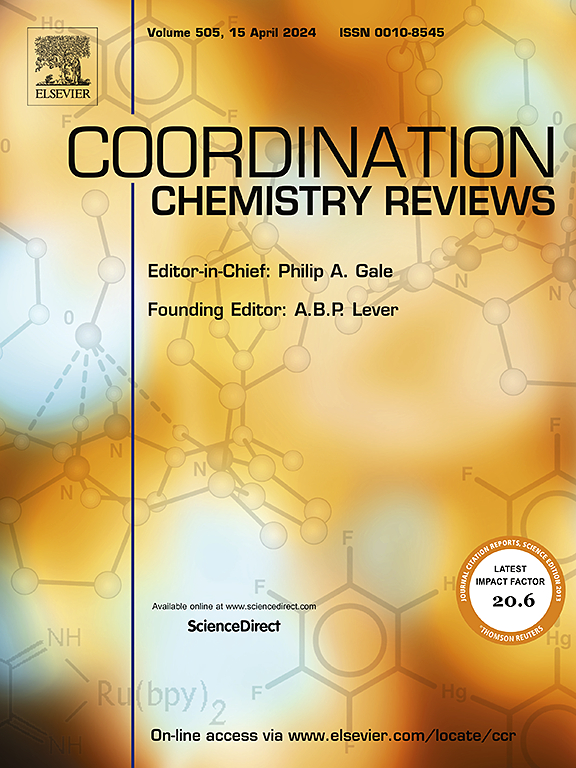柔性表面增强拉曼散射衬底:设计策略、制造技术和应用综述
IF 20.3
1区 化学
Q1 CHEMISTRY, INORGANIC & NUCLEAR
引用次数: 0
摘要
表面增强拉曼散射(SERS)以其灵敏的检测和指纹识别技术而备受关注。在支撑基板上构建等离子体结构集成SERS器件,拓宽了其实际应用。与刚性材料相比,柔性材料具有成本低、无创、易于操作等优点,尤其适用于曲面样品。本文深入探讨了柔性SERS基板的最新进展,重点介绍了优化SERS信号增强的设计策略和实现大规模生产的制造技术。我们介绍了两种新的方法来控制柔性SERS衬底中的热点分布,这是提高信号灵敏度和再现性的关键因素,这在以前的综述中没有得到充分的探讨。此外,我们还提供了各种基于柔性材料的SERS基板的全面概述,包括聚合物,纤维素和其他生物材料,以及它们的典型制造方法。本文还介绍了FSS在生物传感器、食品农药原位检测、环境污染物监测和微流控技术方面的前沿应用,重点介绍了实际应用中的挑战,如衬底均匀性、稳定性和可扩展性。相信本文的综述将有助于材料、纳米光子学和SERS等领域的研究人员设计和开发具有高灵敏度和易于复制的新型FSS,用于化学和生物传感的实际应用。本文章由计算机程序翻译,如有差异,请以英文原文为准。

Flexible surface-enhanced Raman scattering substrates: A review on design strategies, fabrication technologies, and applications
Surface-enhanced Raman scattering (SERS) has drawn great attention due to its sensitive detection and fingerprint identification. Plasmonic structures built on supporting substrate to integrate SERS devices have broadened its practical applications. Compared with rigid materials for supporting substrate, flexible materials have received great interest, in terms low-cost, non-invasive, and easy-operation, especially for curved surface samples. Herein, an in-depth exploration of the latest progress in flexible SERS substrates was presented, which focused on both design strategies for optimizing SERS signal enhancement and the fabrication techniques that enable large-scale production. We introduced two novel approaches for manipulating the hotspot distribution in flexible SERS substrates, a critical factor for improving signal sensitivity and reproducibility, which was underexplored in previous reviews. Furthermore, we provided a comprehensive overview of various flexible materials-based SERS substrates, including polymers, cellulose, and other biomaterials, along with their typical fabrication methods. This review also highlights cutting-edge applications of FSS in biosensors, in-situ detection of food pesticides, environmental pollutants monitoring and microfluidic technology with an emphasis on practical application challenges, such as substrate uniformity, stability, and scalability. It is believed that this review would help the researchers in diverse fields related to materials, nanophotonics, and SERS to design and develop novel FSS with highly sensitive and simply reproducible toward real-world applications in chemical and biological sensing.
求助全文
通过发布文献求助,成功后即可免费获取论文全文。
去求助
来源期刊

Coordination Chemistry Reviews
化学-无机化学与核化学
CiteScore
34.30
自引率
5.30%
发文量
457
审稿时长
54 days
期刊介绍:
Coordination Chemistry Reviews offers rapid publication of review articles on current and significant topics in coordination chemistry, encompassing organometallic, supramolecular, theoretical, and bioinorganic chemistry. It also covers catalysis, materials chemistry, and metal-organic frameworks from a coordination chemistry perspective. Reviews summarize recent developments or discuss specific techniques, welcoming contributions from both established and emerging researchers.
The journal releases special issues on timely subjects, including those featuring contributions from specific regions or conferences. Occasional full-length book articles are also featured. Additionally, special volumes cover annual reviews of main group chemistry, transition metal group chemistry, and organometallic chemistry. These comprehensive reviews are vital resources for those engaged in coordination chemistry, further establishing Coordination Chemistry Reviews as a hub for insightful surveys in inorganic and physical inorganic chemistry.
 求助内容:
求助内容: 应助结果提醒方式:
应助结果提醒方式:


